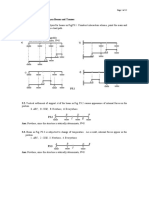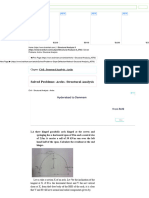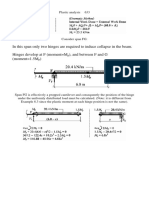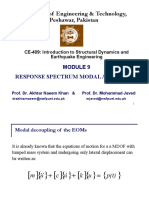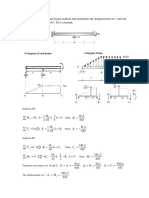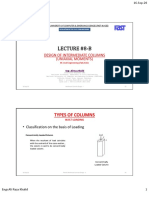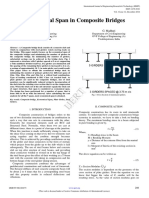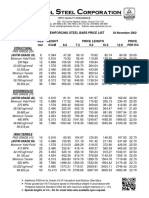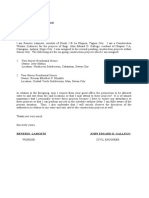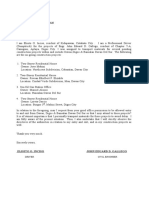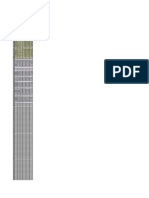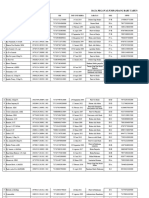Chapter 07 - Composite Beams
Uploaded by
John Eduard GallegoChapter 07 - Composite Beams
Uploaded by
John Eduard GallegoCE 513
STRUCTURAL
STEEL DESIGN
Amie Lou G. Cisneros, CE
Instructor
College of Engineering and Technology
Digos City
COMPOSITE BEAMS
• COMPOSITE CONSTRUCTION
• Refers to a construction method in which cast -
- in place concrete slab is bonded to steel
beams, girders, decking below, such that the
two materials act as a unit.
• 2 TYPES of COMPOSITE BEAMS
• Totally encased beams which depend upon
natural bond for interaction with the concrete
and;
• Those with shear connectors (mechanica
anchorage to the slab) with the steel beam not
necessarily encased.
TOTALLY ENCASED BEAM
Seismology: Earth's Interior & Plate Tectonics
• TOTALLY ENCASED STEEL BEAM
• A beam is totally encased in concrete if it is
casted integrally with the slab.
• It may be assumed to be connected to the
concrete by natural bond, without additional
achorage, provided that:
• Concrete cover over the beam sides and soffit is at
least 50 mm;
• The top of the beam is at least 38 mm below the top
and 50 mm above the bottom of the slab;
• Concrete encasement contains adequate mesh or
other reinforcing steel throughout the whole depth
and across the soffit of the beam to prevent spalling of
the concrete
NON - ENCASED STEEL
BEAM
Seismology: Earth's Interior & Plate Tectonics
• For interior beams of length 𝑳 and spacing 𝒔
(mm) on centers:
𝑳
𝒆𝒇𝒇𝒆𝒄𝒕𝒊𝒗𝒆 𝒘𝒊𝒅𝒕𝒉, 𝒃 = 𝒔𝒎𝒂𝒍𝒍𝒆𝒓 𝒐𝒇 𝒂𝒏𝒅 𝒔
𝟒
• For exterior beams,
𝑳 𝒔
𝒆𝒇𝒇𝒆𝒄𝒕𝒊𝒗𝒆 𝒘𝒊𝒅𝒕𝒉, 𝒃 = 𝒔𝒎𝒂𝒍𝒍𝒆𝒓 𝒐𝒇 𝒂𝒏𝒅 𝒆 +
𝟒 𝟐
• 𝒆 = distance from the beam centerline to the edge of
the slab
SECTION – PROPERTIES
OF COMPOSITE BEAMS
Seismology: Earth's Interior & Plate Tectonics
• The moment of inertia and section modulus of a
composite beam are computed using the
transformed area method.
• The actual area of effective concrete flange is
transformed into steel area by dividing it by the
𝒎𝒐𝒅𝒖𝒍𝒂𝒓 𝒓𝒂𝒕𝒊𝒐, 𝒏.
𝒃
𝑻𝒓𝒂𝒏𝒔𝒇𝒐𝒓𝒎𝒆𝒅 𝑨𝒓𝒆𝒂, 𝑨𝒄𝒕 = 𝒕
𝒏
𝑬𝒔𝒕𝒆𝒆𝒍
𝒏=
𝑬𝒄𝒐𝒏𝒄𝒓𝒆𝒕𝒆
Case 1
FULL COMPOSITE ACTION
Seismology: Earth's Interior & Plate Tectonics
• CASE 1 : FULL COMPOSITE ACTION
• Full composite action is obtained when there is
enough number of shear connectors provided.
• For full composite action,
𝒃
𝒏
= transformed effective width of the slab
• The distance from the neutral axis to the bottom
of the steel beam is:
𝑨𝒔 𝒅/𝟐 + 𝑨𝒄𝒕 𝒅 + 𝒆
𝒚=
𝑨𝒔 + 𝑨𝒄𝒕
• The moment of inertia of the transformed
section is:
𝟐
𝒅 𝟏 𝒃 𝟑 𝟐
𝑰𝒕𝒓 = 𝑰𝒔 + 𝑨𝒔 𝒚− + 𝒕 + 𝑨𝒄𝒕 𝒅 + 𝒆 − 𝒚
𝟐 𝟏𝟐 𝒏
• The section modulus of the transformed section
referred to the bottom flange of the steel beam
is:
𝑰𝒕𝒓
𝑺𝒕𝒓 =
𝒚
• The section modulus of the transformed section
referred to the top of the concrete is:
𝑰𝒕𝒓
𝑺𝒕 =
𝑯−𝒚
Case 2
PARTIAL COMPOSITE ACTION
Seismology: Earth's Interior & Plate Tectonics
• CASE 2 : PARTIAL COMPOSITE ACTION
• In cases where it is not feasible or necessary to
provide adequate connectors to satisfy the
horizontal shear requirements for full composite
action; the effective properties are as follows:
• Effective Moment of Inertia:
𝑽′𝒉
𝑰𝒕𝒓 𝒆𝒇𝒇 = 𝑰𝒔 + 𝑰𝒕𝒓 − 𝑰𝒔
𝑽𝒉
• Effective Section Modulus (referred to bottom
flange)
𝑽′𝒉
𝑺𝒕𝒓 𝒆𝒇𝒇 = 𝑺𝒔 + 𝑺𝒕𝒓 − 𝑺𝒔
𝑽𝒉
• Effective Section Modulus (referred to the top
concrete)
𝑰𝒕𝒓 𝒆𝒇𝒇
𝑺𝒕𝒓 𝒆𝒇𝒇 =
𝑯 − 𝒚𝒆𝒇𝒇
• Effective neutral axis (from the bottom)
𝑰𝒕𝒓 𝒆𝒇𝒇
𝒚𝒆𝒇𝒇 =
𝑺𝒕𝒓 𝒆𝒇𝒇
• Transformed effective width:
𝒅
𝒃 𝑨𝒔 𝒚 𝒆𝒇𝒇 − 𝒔 𝒃
= 𝒕 ≤
𝒏 𝒆𝒇𝒇
𝒕 𝒅+ −𝒚 𝒏
𝟐 𝒆𝒇𝒇
Where:
𝑽𝒉 = the total horizontal shear to be resisted by
the connectors between the point of maximum
positive moment and point of zero moment
𝑽𝒉 = 𝒔𝒎𝒂𝒍𝒍𝒆𝒓 𝒐𝒇 𝑽𝒉𝒄 𝒂𝒏𝒅 𝑽𝒉𝒔
𝟎. 𝟖𝟓𝒇′𝒄 𝑨𝒄
𝑽𝒉𝒄 =
𝟐
𝑭𝒚 𝑨𝒔
𝑽𝒉𝒔 =
𝟐
Where:
𝑽′𝒉 = the total horizontal shear to be resisted by
the connectors between the point of maximum
positive moment and point of zero moment under
partial composite action and must not be less
𝟏
than 𝟒 𝑽𝒉 .
𝑽′𝒉 = 𝒒𝑵𝟏
𝒒 = allowable shear load for one connector
𝑵𝟏 = number of shear connectors furnished
between the point of maximum moment and
point of zero moment
Where:
𝑰𝒔 = the moment of inertia of the steel action,
𝒎𝒎𝟒
𝑺𝒔 = section modulus of the steel action, 𝒎𝒎𝟑
𝑨𝒔 = cross sectional area of the steel section,
𝒎𝒎𝟐
𝑨𝒄 = actual area of effective concrete flange,
𝒎𝒎𝟐
𝑨𝒄 = 𝒃𝒕
You might also like
- 425-Chp7-Bond Development Length SplicesNo ratings yet425-Chp7-Bond Development Length Splices41 pages
- CIVL 5830 Advanced Mechanics of Materials - Final Exam (Spring, 2020)100% (1)CIVL 5830 Advanced Mechanics of Materials - Final Exam (Spring, 2020)3 pages
- Study of a reluctance magnetic gearbox for energy storage system applicationFrom EverandStudy of a reluctance magnetic gearbox for energy storage system application1/5 (1)
- For General Tax Questions Call Our Toll Free Number0% (1)For General Tax Questions Call Our Toll Free Number2 pages
- Chapter 3b - Analysis of Tension MembersNo ratings yetChapter 3b - Analysis of Tension Members56 pages
- Module 2 Shear and Moment in Determinate BeamsNo ratings yetModule 2 Shear and Moment in Determinate Beams13 pages
- CE 370-Lecture-23 (Development of Interaction Diagrams) (Read-Only) PDFNo ratings yetCE 370-Lecture-23 (Development of Interaction Diagrams) (Read-Only) PDF33 pages
- 3 CE131P - Analysis of Statically Determinate Structures v2 (Robles)No ratings yet3 CE131P - Analysis of Statically Determinate Structures v2 (Robles)23 pages
- ENGINEERING MECHANICS VOL L STATICS FIFTH EDITION Chapter6 PDFNo ratings yetENGINEERING MECHANICS VOL L STATICS FIFTH EDITION Chapter6 PDF59 pages
- 507 39 Solutions Instructor Manual Chapter 4100% (1)507 39 Solutions Instructor Manual Chapter 42 pages
- RCD Lesson 1b Flexural Analysis of Beams (Cracking Moment)No ratings yetRCD Lesson 1b Flexural Analysis of Beams (Cracking Moment)14 pages
- Analysis of Doubly Reinforced Concrete BeamNo ratings yetAnalysis of Doubly Reinforced Concrete Beam4 pages
- University of Engineering & Technology, Peshawar, Pakistan: Response Spectrum Modal AnalysisNo ratings yetUniversity of Engineering & Technology, Peshawar, Pakistan: Response Spectrum Modal Analysis48 pages
- Prc-I Lec 7 - 18th March 014 - Flexural Analysis of BeamsNo ratings yetPrc-I Lec 7 - 18th March 014 - Flexural Analysis of Beams51 pages
- Group 5 DESIGN OF SIMPLE SPAN STEEL HIGHWAY THROUGH TRUSS BRIDGE - 073925No ratings yetGroup 5 DESIGN OF SIMPLE SPAN STEEL HIGHWAY THROUGH TRUSS BRIDGE - 07392586 pages
- L14 - Design of Compression Members - Eccentrically LoadedNo ratings yetL14 - Design of Compression Members - Eccentrically Loaded29 pages
- Proposed 1 Storey Steel Building Type A (1 No) Covid Care Center Laboratory and Sterilization BuildingNo ratings yetProposed 1 Storey Steel Building Type A (1 No) Covid Care Center Laboratory and Sterilization Building18 pages
- Chapter 4 Analysis of Statically Determinate Beams: Learning ObjectivesNo ratings yetChapter 4 Analysis of Statically Determinate Beams: Learning Objectives62 pages
- 3 Flanged Beams Practice Problems SolutionsNo ratings yet3 Flanged Beams Practice Problems Solutions17 pages
- 5 CE131P - Beams and Frames - Shear and Bending Moment (Robles)No ratings yet5 CE131P - Beams and Frames - Shear and Bending Moment (Robles)23 pages
- Unit 4.2 Analysis of Statically Indeterminate Beams - Moment Distribution Method (Part 2)100% (1)Unit 4.2 Analysis of Statically Indeterminate Beams - Moment Distribution Method (Part 2)4 pages
- 2.3 Section Properties of Built-Up Steel Sections PDFNo ratings yet2.3 Section Properties of Built-Up Steel Sections PDF5 pages
- Evaluation of Shear Strength of High Strength Concrete BeamsNo ratings yetEvaluation of Shear Strength of High Strength Concrete Beams266 pages
- Lec9 Strength Design Methoddoubly Reinforced Beams 160214192041 PDFNo ratings yetLec9 Strength Design Methoddoubly Reinforced Beams 160214192041 PDF8 pages
- Design of One Way Slab: Reference: NSCP 2001 Volume 1 Design of Reinforced Concrete by J.C. MccormacNo ratings yetDesign of One Way Slab: Reference: NSCP 2001 Volume 1 Design of Reinforced Concrete by J.C. Mccormac25 pages
- Flexural-Torsional Buckling of Compression Members PDF100% (1)Flexural-Torsional Buckling of Compression Members PDF33 pages
- Looks Like You've Reached Your Device Limit: Steel DesignNo ratings yetLooks Like You've Reached Your Device Limit: Steel Design17 pages
- Numerical Methods and Implementation in Geotechnical Engineering – Part 1From EverandNumerical Methods and Implementation in Geotechnical Engineering – Part 1No ratings yet
- Ijert Ijert: Economical Span in Composite BridgesNo ratings yetIjert Ijert: Economical Span in Composite Bridges4 pages
- Steel Structures 3 - Composite Steel-Concrete Structures - Slides Lecture 4 To 6No ratings yetSteel Structures 3 - Composite Steel-Concrete Structures - Slides Lecture 4 To 646 pages
- Chapter 06 - Beam and Other Flexural MembersNo ratings yetChapter 06 - Beam and Other Flexural Members60 pages
- CE 321 - Steel Design (Columns and Other Compression Mmembers)100% (1)CE 321 - Steel Design (Columns and Other Compression Mmembers)42 pages
- CE 321 - Steel Design (Bolted and Riveted Connections)100% (1)CE 321 - Steel Design (Bolted and Riveted Connections)51 pages
- CE 321 - Steel Design (Beams & Flexural Members)No ratings yetCE 321 - Steel Design (Beams & Flexural Members)40 pages
- Reinforcing Steel Bars Price List: Structural (Astm Grade 33)No ratings yetReinforcing Steel Bars Price List: Structural (Astm Grade 33)1 page
- Jose Mari Rafael Rodriguez: Respectfully YoursNo ratings yetJose Mari Rafael Rodriguez: Respectfully Yours1 page
- Alert! How To Get The Rashan From The Ehsaas Rashan Riayat Program, Latest Method 2024No ratings yetAlert! How To Get The Rashan From The Ehsaas Rashan Riayat Program, Latest Method 20243 pages
- Climate Change Imitigation and Adaptation Day6 Grade 9No ratings yetClimate Change Imitigation and Adaptation Day6 Grade 96 pages
- Ch.3 13ed Analysis of Fin Stmts MiniC SolsNo ratings yetCh.3 13ed Analysis of Fin Stmts MiniC Sols7 pages
- Retrouvez Vos Chaines, Satellites, Positions de l'EST À l'OUEST Ici en Suivant L'ordre AlphabétiqueNo ratings yetRetrouvez Vos Chaines, Satellites, Positions de l'EST À l'OUEST Ici en Suivant L'ordre Alphabétique29 pages
- Zaposh Consultancy and Services To Make The Workplace Safer, Healthier and More ProductiveNo ratings yetZaposh Consultancy and Services To Make The Workplace Safer, Healthier and More Productive40 pages
- PDF Conservation Technology Serge A. Wich download100% (1)PDF Conservation Technology Serge A. Wich download41 pages
- Departmentalization in Management - Definition, Types & Advantages - Education PortalNo ratings yetDepartmentalization in Management - Definition, Types & Advantages - Education Portal2 pages
- Lean Healthcare in Developing Countries: Evidence From Brazilian HospitalsNo ratings yetLean Healthcare in Developing Countries: Evidence From Brazilian Hospitals22 pages
- Prof. K. Viyyana Rao, Vice-Chancellor, Acharya Nagarjuna University. 2. Prof. M. Srimannarayana, Professor in XLRI University, JamshedpurNo ratings yetProf. K. Viyyana Rao, Vice-Chancellor, Acharya Nagarjuna University. 2. Prof. M. Srimannarayana, Professor in XLRI University, Jamshedpur1 page
- Lifecycle Assessment Of Semiconductors 1st Edition Sarah B Boyd Auth downloadNo ratings yetLifecycle Assessment Of Semiconductors 1st Edition Sarah B Boyd Auth download76 pages
- MG University B Tech 8th Semester SyllabusNo ratings yetMG University B Tech 8th Semester Syllabus19 pages
- Your RBC Personal Savings Account Statement50% (2)Your RBC Personal Savings Account Statement3 pages


